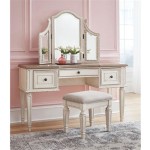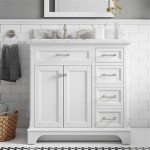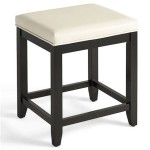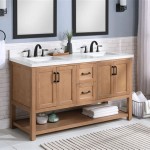What Is the Standard Height of a Bathroom Vanity?
The bathroom vanity serves as a focal point in the bathroom, providing storage and functionality centered around the sink. One of the critical considerations when selecting a bathroom vanity is its height. The height of the vanity significantly impacts user comfort and the overall ergonomics of the bathroom space. While personal preferences and specific needs play a role, understanding the standard height and available alternatives is crucial for making an informed decision. This article explores the standard height of a bathroom vanity, factors influencing height selection, and available options to optimize bathroom design.
Understanding the Standard Height
For many years, the standard height of a bathroom vanity was 30 to 32 inches. This height was deemed suitable based on average adult height and ease of use. However, as average heights have increased and awareness of ergonomic design has improved, the standard height has gradually shifted. The current standard height for a bathroom vanity is generally accepted to be 34 to 36 inches. This height is often referred to as "comfort height" because it tends to be more comfortable for a wider range of users, particularly adults.
The transition to comfort height vanities reflects a growing understanding of the impact of countertop height on posture and strain. A lower vanity height can force users to bend over excessively to use the sink, which can lead to back pain and discomfort over time. The increased height of comfort height vanities aims to minimize this bending, promoting a more natural and comfortable posture. While the 34 to 36-inch range is considered the standard, it is important to remember that this is a guideline, and individual needs and preferences should always be considered.
It's also worth noting that the measurement refers to the height from the floor to the top of the vanity countertop. This measurement includes the base cabinet, the countertop material, and any sink that sits on top of the counter. Therefore, when assessing the height of an existing vanity or planning for a new installation, it's crucial to consider the total height including all components.
Factors Influencing Vanity Height Selection
Selecting the appropriate vanity height involves considering various factors beyond the standard measurements. These factors include the height of the primary users, the overall bathroom design, and specific accessibility requirements. Taking these considerations into account ensures the vanity height optimizes comfort, functionality, and aesthetics.
The height of the primary users is a critical consideration. If the bathroom is primarily used by individuals who are shorter than average, a vanity closer to the original 30 to 32-inch standard may be more appropriate. Conversely, if the users are taller than average, a vanity slightly taller than the current 34 to 36-inch standard might be preferable. Measuring the height of the users and observing their posture when using a sink at different heights can help determine the ideal vanity height. A good rule of thumb is to aim for a height that allows the user to use the sink with their back straight and without excessive bending.
The overall bathroom design and style also play a role in vanity height selection. In some cases, a lower vanity might complement a specific design aesthetic, such as a minimalist or modern style. Conversely, a taller vanity might be more suitable for a traditional or transitional bathroom design. The architectural style of the home and existing bathroom fixtures should also be considered to ensure the vanity height integrates seamlessly with the overall design.
Accessibility requirements are another significant factor. Bathrooms designed for individuals with mobility limitations may require vanities that comply with the Americans with Disabilities Act (ADA) standards. ADA-compliant vanities typically have a maximum height of 34 inches to ensure they are accessible to individuals in wheelchairs. These vanities often feature open space underneath the sink to allow for comfortable wheelchair access. When designing or renovating a bathroom for accessibility, it’s essential to consult the ADA guidelines and consider the specific needs of the users.
Exploring Alternative Vanity Heights and Custom Options
While the standard height of 34 to 36 inches and the ADA-compliant height of 34 inches serve as useful guidelines, alternative heights and custom options are available to accommodate unique needs and preferences. These options allow for greater flexibility in bathroom design and can optimize comfort and functionality for individual users.
One alternative is to opt for a shorter vanity, falling within the 30 to 32-inch range. This height can be suitable for powder rooms or bathrooms primarily used by children. A lower vanity can make it easier for children to reach the sink and use the faucet independently. In powder rooms, where the sink is primarily used for handwashing, a lower vanity can also serve as a design choice to create a more compact and aesthetically pleasing space.
Another alternative is to choose a taller vanity, exceeding the 36-inch standard. Taller vanities can be beneficial for taller individuals, as they minimize bending and promote better posture. These vanities can also provide additional storage space, which can be particularly useful in smaller bathrooms. When selecting a taller vanity, it's essential to ensure that the countertop height is comfortable and proportionate to the overall bathroom design.
Custom vanities offer the ultimate flexibility in height selection. With a custom vanity, the height can be tailored to the specific needs and preferences of the users. Custom vanities also allow for unique design features, such as integrated sinks, custom storage solutions, and personalized finishes. While custom vanities may be more expensive than standard options, they can provide a perfect fit and optimize both functionality and aesthetics. Working with a professional designer or cabinet maker can help create a custom vanity that meets all the specific requirements of the bathroom and its users.
Adjustable height vanities are also emerging as a viable option. These vanities allow the user to adjust the height of the countertop as needed. They are particularly useful in bathrooms used by individuals of varying heights or in homes seeking to age in place. Adjustable height vanities can be raised or lowered using a manual or electric mechanism, providing a flexible and ergonomic solution for users of all ages and abilities.
In conclusion, while a standard vanity height offers a general guideline, the best choice always depends on specific needs. Understanding the factors influencing vanity height selection and exploring alternative options allows homeowners and designers to create bathrooms that are both functional and aesthetically pleasing.

What Is The Standard Bathroom Vanity Height Size Guide

What Is The Standard Bathroom Vanity Height Bfy Mirror

Bathroom Vanity Height Choosing The Perfect Fit For Your Space

What Is The Standard Bathroom Vanity Height Size Guide

What Is The Standard Height Of A Bathroom Vanity

How To Choose The Best Bathroom Sink Height A Complete Guide

What Are Standard Bathroom Vanity Sizes And Size Do I Need Wide Canvas

How To Choose The Best Bathroom Sink Height A Complete Guide

Bathroom Vanity Heights Sizes Everything Explained

What Is The Standard Bathroom Vanity Height Bfy Mirror







